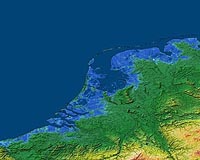| . |  |
. |
Seattle WA (SPX) Dec 06, 2010 For years, geologists have argued about the processes that formed steep inner gorges in the broad glacial valleys of the Swiss Alps. The U-shaped valleys were created by slow-moving glaciers that behaved something like road graders, eroding the bedrock over hundreds or thousands of years. When the glaciers receded, rivers carved V-shaped notches, or inner gorges, into the floors of the glacial valleys. But scientists disagreed about whether those notches were erased by subsequent glaciers and then formed all over again as the second round of glaciers receded. New research led by a University of Washington scientist indicates that the notches endure, at least in part, from one glacial episode to the next. The glaciers appear to fill the gorges with ice and rock, protecting them from being scoured away as the glaciers move. When the glaciers receded, the resulting rivers returned to the gorges and easily cleared out the debris deposited there, said David Montgomery, a UW professor of Earth and space sciences. "The alpine inner gorges appear to lay low and endure glacial attack. They are topographic survivors," Montgomery said. "The answer is not so simple that the glaciers always win. The river valleys can hide under the glaciers and when the glaciers melt the rivers can go back to work." Montgomery is lead author of a paper describing the research, published online Dec. 5 in Nature Geoscience. Co-author is Oliver Korup of the University of Potsdam in Germany, who did the work while with the Swiss Federal Research Institutes in Davos, Switzerland. The researchers used topographic data taken from laser-based (LIDAR) measurements to determine that, if the gorges were erased with each glacial episode, the rivers would have had to erode the bedrock from one-third to three-quarters of an inch per year since the last glacial period to get gorges as deep as they are today. "That is screamingly fast. It's really too fast for the processes," Montgomery said. Such erosion rates would exceed those in all areas of the world except the most tectonically active regions, the researchers said, and they would have to maintain those rates for 1,000 years. Montgomery and Korup found other telltale evidence, sediment from much higher elevations and older than the last glacial deposits, at the bottom of the river gorges. That material likely was pushed into the gorges as glaciers moved down the valleys, indicating the gorges formed before the last glaciers. "That means the glaciers aren't cutting down the bedrock as fast as the rivers do. If the glaciers were keeping up, each time they'd be able to erase the notch left by the river," Montgomery said. "They're locked in this dance, working together to tear the mountains down." The work raises questions about how common the preservation of gorges might be in other mountainous regions of the world. "It shows that inner gorges can persist, and so the question is, 'How typical is that?' I don't think every inner gorge in the world survives multiple glaciations like that, but the Swiss Alps are a classic case. That's where mountain glaciation was first discovered."
Share This Article With Planet Earth
Related Links University of Washington Beyond the Ice Age
 Global Sea-Level Rise At The End Of The Last Ice Age
Global Sea-Level Rise At The End Of The Last Ice AgeSouthampton, UK (SPX) Dec 02, 2010 Southampton researchers have estimated that sea-level rose by an average of about 1 metre per century at the end of the last Ice Age, interrupted by rapid 'jumps' during which it rose by up to 2.5 metres per century. The findings, published in Global and Planetary Change, will help unravel the responses of ocean circulation and climate to large inputs of ice-sheet meltwater to the world ocean. ... read more |
|
| The content herein, unless otherwise known to be public domain, are Copyright 1995-2010 - SpaceDaily. AFP and UPI Wire Stories are copyright Agence France-Presse and United Press International. ESA Portal Reports are copyright European Space Agency. All NASA sourced material is public domain. Additional copyrights may apply in whole or part to other bona fide parties. Advertising does not imply endorsement,agreement or approval of any opinions, statements or information provided by SpaceDaily on any Web page published or hosted by SpaceDaily. Privacy Statement |